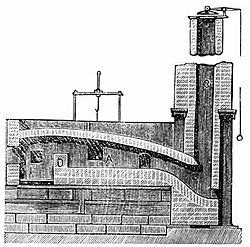Henry Cort facts for kids
Quick facts for kids
Henry Cort
|
|
|---|---|

Henry Cort
|
|
| Born |
Henry Cort
Circa 1740 Unknown
|
| Died | Friday 23 May 1800 |
| Nationality | English |
| Occupation | Inventor, pioneer in the iron industry |
| Known for | Inventions relating to puddling and rolling in the manufacture of iron. |
| Children | Richard Cort |
Henry Cort (born around 1740 – died May 23, 1800) was an English inventor and iron producer. He played a very important role during the Industrial Revolution in England. Cort developed new ways to turn pig iron (a raw form of iron) into wrought iron (a stronger, more useful type of iron).
In 1784, he received a patent for an improved method called the puddling process. This process helped refine cast iron. He also invented grooved rollers, which made shaping iron much easier. These inventions changed how iron was made and helped Britain become a leader in iron production.
Contents
Henry Cort's Early Life
We don't know much about Henry Cort's early life. He was likely born around 1740, possibly in Lancaster, England. His parents are unknown, and many details about his childhood remain a mystery.
By 1765, Cort worked as a pay agent for the Royal Navy. This meant he helped collect payments and pensions for Navy officers and their families. At this time, making iron in Britain was difficult and expensive. Even with improvements by Abraham Darby I, who used coke instead of charcoal to melt iron, turning it into useful bar iron was a long, hard process. Because of this, Britain had to buy a lot of its iron from other countries.
In 1768, Henry Cort married Elizabeth Heysham. Her family had connections to the iron business, which helped Cort get involved in the industry. Her uncle owned an ironmongery business in Gosport that supplied the Navy with many iron items like chains and anchors.
Developing New Iron Methods
In 1780, Cort took over his wife's uncle's business. He made a deal with the Royal Navy to supply iron parts for their ships. This led him to invest in a new rolling mill at a place called Titchfield. This mill was later used to produce bar iron.
Cort needed more money for his projects. He got a large loan from Adam Jellicoe, a chief clerk in the Royal Navy's Pay Office. As part of the deal, Jellicoe's son, Samuel, became a partner in Cort's ironworks, which Cort renamed Fontley Works. This financial arrangement later caused big problems for Cort.
Cort's Key Inventions
At Fontley Works, Henry Cort developed his most important inventions. In 1783, he patented a new type of furnace called a reverberatory furnace. This furnace heated iron from above, making it easier to refine.
His most famous invention, patented in 1784, was the puddling furnace with grooved rollers.
- The puddling furnace was a special oven where workers could stir molten (melted) pig iron. This stirring helped remove impurities and lower the carbon content, turning the pig iron into higher-quality wrought iron. The worker who did this was called a "puddler."
- The grooved rollers were a major breakthrough. After the iron was "puddled" and formed into a ball, it was hammered into a rough shape. Then, it was passed through these rollers. The grooves in the rollers helped shape the iron into bars and other forms much faster and more easily than before. This made the process of making iron much more efficient.
Cort's original puddling process worked best with iron made using charcoal. However, most iron at the time was made using coke. Other ironmasters, like Richard Crawshay, made important changes to Cort's process so it would work better with coke-smelted iron. These changes made the puddling process very successful.
Financial Troubles and Patents
In 1789, Adam Jellicoe, who had lent Cort money, died suddenly. It turned out that the large loan to Cort could not be repaid. Because of this, the government took control of all of Jellicoe's property, as well as Cort's business. Henry Cort was held responsible for the debt and declared bankrupt. This meant he lost his business and his patents.
Even though Cort faced financial ruin, his inventions were seen as very important. In 1786, a politician named Lord Sheffield said that Cort's work on iron was as important as James Watt's work on the steam engine.
In 1787, Cort made a deal with a Welsh ironmaster named Richard Crawshay. Cort was supposed to receive a payment (called a royalty) for every ton of iron made using his patented methods. However, because his process was modified by others and he lost control of his patents, he didn't earn much from his inventions.
Henry Cort's Personal Life
Henry Cort and his wife Elizabeth had 13 children. Despite his amazing inventions that changed the iron industry, Cort did not become wealthy. Many thousands of puddling furnaces were used after his time, but they often used modified versions of his process, which meant no royalties were paid to him.
He later received a small pension from the government, but he died without much money. Henry Cort was buried in a churchyard in London.
Henry Cort's Legacy
Fifty years after Henry Cort's death, a famous newspaper called The Times described him as "the father of the iron trade." This shows how important his contributions were to the industry.
His son, Richard Cort, later worked for an iron company and wrote about the iron industry and early railway companies.
Today, The Henry Cort Community College in Fareham, England, is named after him. Also, a busway between Fareham and Bridgemary is called Henry Cort Way. These names remind us of his lasting impact.


